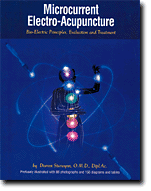Spearheaded by burgeoning scientific and clinical research literature, psychedelics have reached a level of media coverage and popular interest that has not been seen for over half a century. By “psychedelics,” we are referring to the unique class of substances that includes psilocybin (the active compound found in so-called “magic mushrooms”), LSD, dimethyltryptamine (DMT), ayahuasca, 5-MeO-DMT, and mescaline – each of which occurs in the natural world (except for LSD, which is a semi-synthetic compound).
Microcurrent Electro-Acupuncture: Bio-Electric Principles, Evaluation and Treatment
| Title: | Microcurrent Electro-Acupuncture: Bio-Electric Principles, Evaluation and Treatment |
| Author: | Darren Starwynn, OMD, Dipl.Ac. |
| Publisher: | Desert Heart Press, Phoenix, Ariz., 2002 |
| Publication: | Softcover, 317 pages |
| Category: | Technique/practitioner education |
| Price: | $49.95 |
| Part #: | T-225 |

Two incidents come to mind concerning my early history with electromedicine. Years ago, when my wife did her physical therapy internship at a major medical center, the supervising physical therapist did something my wife found perplexing: She kept all the settings the same on the treatment device she was using, except for the intensity, which she raised to patient tolerance. When my wife asked the therapist why, she became agitated and provided no satisfactory answer.
The second incident involved an intelligent, articulate chiropractor/physical therapist friend of mine who said something that was simultaneously disturbing and quite interesting. He announced that the vast majority of health-care providers get mediocre results when they use electricity, because they don't understand how it works. He also remarked that the two most effective forms of electricity were microcurrent and interferential. His comment stayed in my head, because this man was not prone to making idle generalizations. Years later, after attending a lecture by Darren Starwynn, the reasons my friend's statement was probably right began to crystallize.
Information about electrical devices usually is provided by manufacturers, who are more concerned with selling machines than healing people. Dr. Starwynn, although a manufacturer of a sophisticated device, is primarily an educator. His book, an outgrowth of his lecturing and writing, is testimony to that fact.
Most books on healing fit into two categories: reference works, which people can credibly, quote from, and books you read from cover to cover. The latter are primers that concentrate on the rudiments of a subject and rarely have the page-turning power of a Stephen King novel. This microcurrent book fuses the divisions. Dr. Starwynn is a storyteller par excellence, and his book includes 86 photographs; 156 diagrams; innumerable footnotes; and enough clinical "meat" to choke a T-Rex.
Starwynn starts each discussion with the basics, then combines them to reach cognitions that will leave clinicians working at a new level. After reading this book, your electroacupuncture abilities will make a quantum leap. Meridians don't seem to follow obvious anatomical pathways, yet research quoted in this book reveals much greater conductance when electrodes are placed on the same meridians. Acupuncture points have never been satisfactorily delineated physiologically from adjacent areas, but they are 50 percent more conductive than nonpoints, and they have greater capacitance (ability to store charge).
This book discusses the "beaver dam" theory, and reveals why six seconds of stimulation can change a patient's range-of-motion of an injured limb. This explains why such a short burst of electrical stimulation causes a burst of physiological changes immediately after application. The analogy is that when a beaver dam is destroyed, there is an immediate increase in water flow. Another area addresses why a stationary needle conducts electricity initially, but slowly stops. This is similar to how a dry cell goes dead from electrolytic changes. As an interesting aside, manipulation of the needle restores the electrical flow.
There are discussions concerning the PPP (proximal probe positive) doctrine and its possible applications. There also is discussion on general physical-therapy-style electrotherapy, but even this has practical applications.
My favorite chapter, however, concerns the four-step approach. Dr. Starwynn states that ideally, a pain patient would get complete care if he or she received manipulation to the skeleton when indicated; body work or acupuncture to release myofascial constrictions; acupuncture to balance the meridians to promote healing and address the root; and finally, drugs, surgery or whatever is needed in an emergency. That is not likely to happen in one facility, but the four-step approach is a pretty good substitute.
Within this framework, a comprehensive treatment can be given. You can use electronic meridian testing, as developed by the Japanese acupuncturist Nakatani. This method is also called ryodoraku, which means "good electro-permeable point." Another option is the electro-acupunture testing developed by Reinhold Voll, which utilizes additional meridians beyond those developed in TCM.
The book concludes with a treatment formulary section that includes references to Dr. Janet Travell's trigger points; auriculotherapy; Dr. Tan's points; Dr. Manaka's points; and other clinical knowledge gained after years of diligent effort.
This book is a treasure. After reading and studying it, you will never feel complete merely adjusting the intensity of an electronic device as different patients come for treatment. You also may come to the conclusion that microcurrent and interferential are the two best forms of electroacupuncture, but even if you don't, you will know a heck of a lot about how microcurrent and electroacupuncture work. One thing you can safely predicate: After reading the book, you won't be limited to just making an adjustment to the intensity knob. This book rates a 10 and automatically becomes the standard for all future books on this subject.
Dr. Lavitan's rating:
10 out of 10
If you have authored, published or produced a book, audio or video package that is chiropractic-oriented, educational, nonpromotional and written or produced in a professional manner, and would like it reviewed in Dynamic Chiropractic, please send two copies of the book, video or audiocassette to:
Review Editor
Dynamic Chiropractic
P.O. Box 4109
Huntington Beach, California 92605-4109
Items submitted for review will not be returned.



